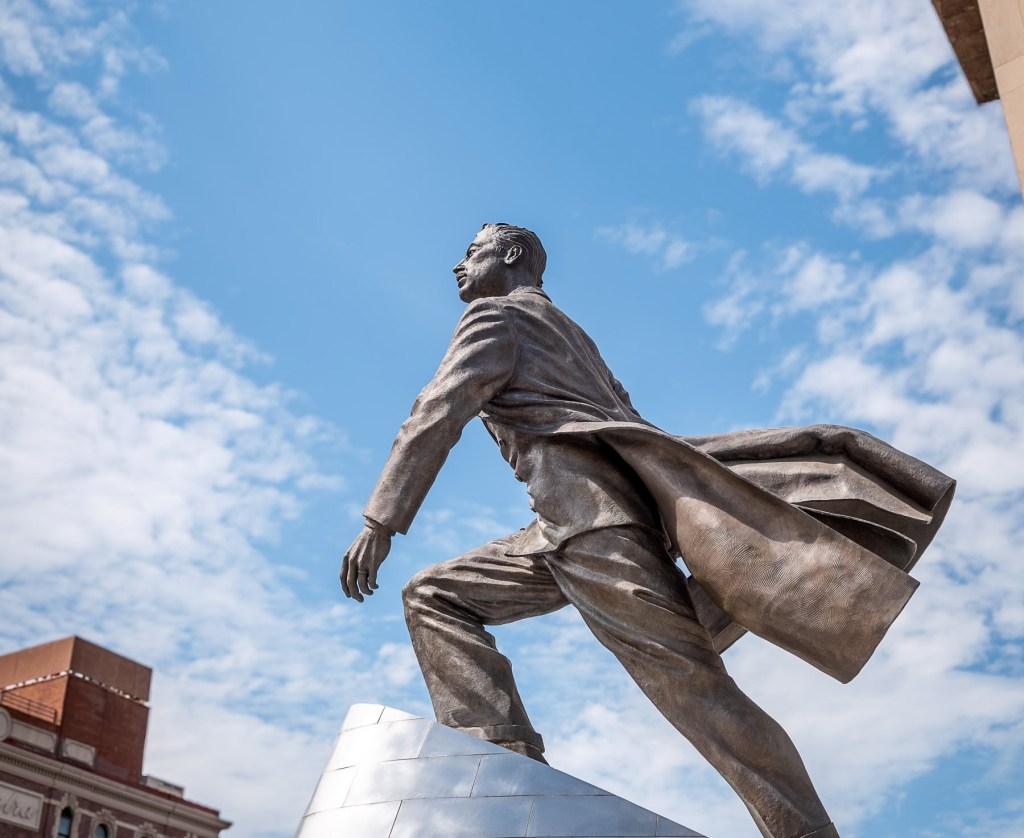30 NYC Monuments of Black Americans You Should Know



In Upper Manhattan, amid the vibrant green foliage of Riverside Park, the whiz of rushing cars from the West Side highway, and the hum of bustling Harlem apartments, a 15-foot-tall bronze depicts the hollow outline of a man frozen mid-stride with one cautious hand raised. A quote from Ralph Ellison’s pioneering 1952 novel is etched into the surface of a low-lying granite panel: “I am an invisible man… I am invisible, understand, simply because people refuse to see me.”
The memorial honoring the Oklahoma-born writer and scholar, who resided across the street at 730 Riverside Drive, was created by the Black revolutionary artist Elizabeth Catlett, who spent her six-decade career drawing attention to the lives and experiences of Black and Mexican women through paintings, sculptures, and prints. Her only public art commission in New York, “Invisible Man: A Memorial to Ralph Ellison,” unveiled in 2003, remains one of the few monuments in the city honoring a Black American that was also created by a Black artist. (A little more than 2% of the city’s 800 outdoor public monuments were created by Black artists.)
The work is among 30 public sculptures and bas-reliefs featured in the recently published book New York City Monuments of Black Americans (2025) by David Felsen.


Right: Gabriel Koren and Algernon Miller, “Frederick Douglass Memorial” (2011)
A high school history teacher in Manhattan’s Chelsea neighborhood, Felsen told Hyperallergic that he started researching the representation of Black Americans in the city’s public memorials amid the nationwide removal of Confederate monuments sparked by Black Lives Matter protests and the murder of George Floyd in 2020.
“ [My classes] use monuments all the time as examples of pieces of art that tell us a lot about a society at a given point in time — what we value, who we value — and then also how that changes,” Felsen said.
As he began delving into the city’s landscape of public artworks, he observed that context for depictions of Black historical figures was “not immediately obvious.”
“ I felt like there was a need for this kind of information out there,” Felsen said.
While there are hundreds of plaques, markers, abstract sculptures, and living memorials honoring Black Americans throughout the city, Felsen’s guide specifically focuses on public visual representations of Black people. Organized chronologically, it begins with the first appearance of a Black American in a New York City monument: a nameless, formerly enslaved Black man featured in a bronze bas-relief panel in the Civil War Soldiers’ Monument (1869) at the Green-Wood Cemetery.

Like all memorials featuring Black individuals over the next seven decades (such as one of the sculptural figures in the Soldiers’ and Sailors’ Memorial Arch in Grand Army Plaza), the man featured in the Green-Wood monument is a symbolic representation of a character rather than the likeness of a real person.
The first monument to pay homage to a real Black individual arrived in 1946 with Richmond Barthé’s bust of author and educator Booker T. Washington, located at the Hall of Fame for Great Americans in Bronx Community College. The unveiling of this work and others that followed, like statues honoring George Washington Carver, Dr. Martin Luther King Jr., and Duke Ellington, coincided with the rise of Black American residents in New York City during the Great Migration of the early 20th century and an increase in Black political representation.



Still, despite this progress in rectifying the gap in racial representation, there is a staggering absence of Black American women in the city’s monuments. New York has long struggled with a glaring underrepresentation of non-men in its public memorials — an issue that initiatives like She Built NYC have only recently begun to address. Abolitionist and activist Sojourner Truth is featured in the Women’s Rights Pioneers monument in Central Park, although she was initially excluded in the original proposal, and a long-awaited tribute to state congresswoman Shirley Chisholm is currently underway, hampered by pandemic-related delays.
Notably, this lack of representation led frustrated activists to install a guerrilla bust honoring trans rights advocate Marsha P. Johnson opposite the Stonewall Inn in 2021.
“Monuments always matter,” Felsen said. “Who we choose to honor is a representation of what we care about and who we care about.”

He added that the significance of these public tributes is especially salient in the current moment, as the Trump administration continues to whitewash history while defunding the arts and humanities.
“ In this particular moment, because the president is essentially trying to erase Black history and because the Department of Defense has decided that they should no longer celebrate Black History Month, the preservation of Black history, wherever it happens, is especially important,” Felsen concluded.





